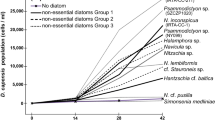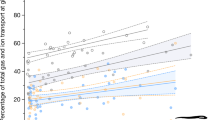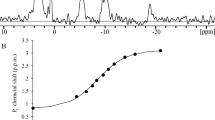Abstract
The erythrocruorins (extracellular haemoglobins from annelids1) have molecular weights of 3–4 ×l06, contain 60–192 O2-binding haem moieties per molecule and are much more complex than the tetrameric vertebrate haemoglobins1–5. However, they perform the same function, carrying O2 from the respiratory surfaces to the tissues, and exhibit similar coopera-tivity in O2 binding and inhibitory heterotropic interactions between O2- and proton-binding sites (Bohr effects), although these functions show greater adaptive variation than in the vertebrate pigments2,3. Whereas erythrocruorin–O2 affinity is insensitive to the anionic organic phosphate cofactors like glycerate-2,3-bisphosphate and ATP1–3, which depress the O2 affinity of vertebrate haemoglobin inside the red blood cells, it is increased by inorganic salts6–8. This effect is important physiologically because annelids lack significant capacity for osmotic regulation and experience large fluctuations in blood electrolyte levels8,9.I show here that, in contrast to the situation in man, where anionic cofactors and protons decrease haemoglobin–O2 affinity by specifically depressing the O2 association equilibrium constant of the pigment in the deoxygenated state10–13, inorganic cations govern the O2 affinity of erythrocruorin from the burrowing, intertidal lugworm, Arenicola marina, by preferentially modifying the association constant of the (almost fully) oxygenated form. In contrast to the vertebrate mechanism, riftich optimizes O2 unloading in the tissues, this alternative control mechanism in erythrocruorin seems to be adaptive to O2 loading at the low O2 tensions generally characteristic of the microenvironments of erythrocruorin-bearing annelids1–3.
This is a preview of subscription content, access via your institution
Access options
Subscribe to this journal
Receive 51 print issues and online access
$199.00 per year
only $3.90 per issue
Buy this article
- Purchase on Springer Link
- Instant access to full article PDF
Prices may be subject to local taxes which are calculated during checkout
Similar content being viewed by others
References
Weber, R. E. in Physiology of Annelids (ed. Mill, P. J.) 393–446 (Academic, New York, 1978).
Magnum, C. P. in Adaptation to Environment (ed. Newell, R. C.) 191–278 (Butterworths, London, 1976).
Weber, R. E. Am. Zool. 20, 79–101 (1980).
Chung, M. C. M. & Ellerton, H. D. Prog. Biophys. molec. Biol. 35, 53–102 (1979).
Wood, E. J. Essays Biochem. 16, 1–47 (1980).
Everaarts, J. M. & Weber, R. E. Comp. Biochem. Physiol. A 48, 507–520 (1974).
Weber, R. E., Bonaventura, J., Sullivan, B. & Bonaventura, C. J. comp. Physiol. 123, 177–184 (1978).
Krogh-Rasmussen, K. & Weber, R. E. Ophelia 18, 151–170 (1979).
Oglesby, L. in Physiology of Annelids (ed. Mill, P. J.) 555–658 (Academic, New York, 1978).
Tyuma, I., Katsuhiko, K. & Imai, K. Biochem. biophys. Res. Commun. 43, 423–428 (1971).
Imai, K. Biochemistry 12, 798–808 (1973); J. biol Chem. 23, 7606–7612 (1974).
Tyuma, I., Imai, K. & Shimizu, K. Biochemistry 12, 1491–1498 (1973).
Imai, K. & Yonetani, T. J. biol. Chem. 250, 2227–2231 (1975).
Wyman, J. Adv. Protein Chem. 19, 223–286 (1964).
Monod, J., Wyman, J. & Changeux, J. -P. J. molec. Biol. 12, 88–118 (1965).
Toulmond, A. Resp. Physiol. 19, 130–144 (1973).
Warren, L. M., Wells, R. M. G. & Weber, R. E. J. exp. mar. Biol. Ecol. (in the press).
Mangum, C. P. Physiol. Zool. 49, 85–99 (1976).
Weber, R. E. Comp. Biochem. Physiol. 35, 179–189 (1970).
Sick, H. & Gersonde, K. Analyt. Biochem. 32, 362–376 (1969).
Author information
Authors and Affiliations
Rights and permissions
About this article
Cite this article
Weber, R. Cationic control of O2 affinity in lugworm erythrocruorin. Nature 292, 386–387 (1981). https://doi.org/10.1038/292386a0
Received:
Accepted:
Issue Date:
DOI: https://doi.org/10.1038/292386a0
This article is cited by
-
Comparison of hematological traits and oxygenation properties of hemoglobins from highland and lowland Asiatic toad (Bufo gargarizans)
Journal of Comparative Physiology B (2021)
-
Globin E is a myoglobin-related, respiratory protein highly expressed in lungfish oocytes
Scientific Reports (2019)
-
Enthalpic consequences of reduced chloride binding in Andean frog (Telmatobius peruvianus) hemoglobin
Journal of Comparative Physiology B (2014)
-
Oxygen equilibria of cathodic eel hemoglobin analysed in terms of the MWC model and Adair's successive oxygenation theory
Journal of Comparative Physiology B (1996)
-
Effect of oxygen and salt on haemolymph oxygen binding in the brine shrimp Artemia franciscana
Marine Biology (1994)
Comments
By submitting a comment you agree to abide by our Terms and Community Guidelines. If you find something abusive or that does not comply with our terms or guidelines please flag it as inappropriate.



